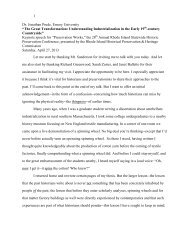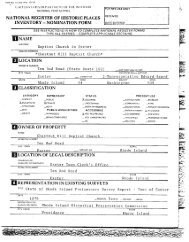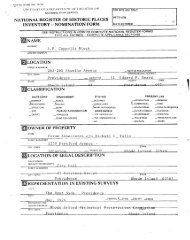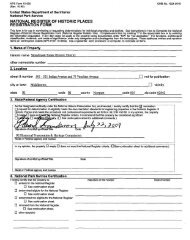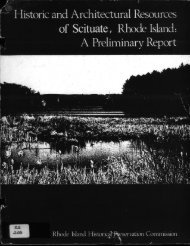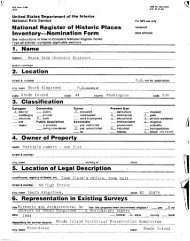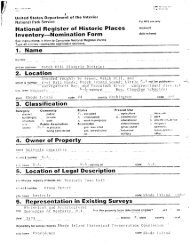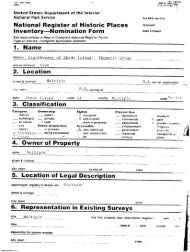National Register of Historic Places Registration Form
National Register of Historic Places Registration Form
National Register of Historic Places Registration Form
Create successful ePaper yourself
Turn your PDF publications into a flip-book with our unique Google optimized e-Paper software.
NPS <strong>Form</strong> 10-900-a - 0MB Approval No. l02400188-86United States Department <strong>of</strong> the Interior<strong>National</strong> Park Service<strong>National</strong> <strong>Register</strong> <strong>of</strong> <strong>Historic</strong> <strong>Places</strong>Continuation SheetPropertyname Clement Weaver - Daniel Howland House, Kent County, P.1.Section number 8 Page 13Cull, set to work on the house sometime in 1937, presumably for ownerEllswworth Gale.Norman Morrison Isham 1864-1943 was an architect practicing inProvidence, Rhode Island where he taught architecture at Brown Universityand the Rhode Island School <strong>of</strong> Design, serving as head <strong>of</strong> PISD’sArchitecture Department from 1912 until 1920 and again from 1923 until1933. Ishahm was the first serious student <strong>of</strong> Rhode Island’s and southernNew England’s "first period" houses and public buildings. In such booksas Early Phode Island Houses with Albert F. Brown, Providence 1895 andEarly Connecticut Houses with Brown, Providence 1900 , he carefullystudied and sketched building techniques and forms used by seventeenth- andeighteenth-century housewrights. In his studies, where he advocatedpreparation <strong>of</strong> "accurate measured drawings" and collection <strong>of</strong> "scientificdata," Isham not only laid the groundwork for all subsequent research onearly New England houses, but he also documented many period houses whichhave since vanished from the landscape. -Isham directed or consulted on numerous restoration projects in RhodeIsland, several <strong>of</strong> which involved archaeological excavations as a method <strong>of</strong>collecting scientific data, and much <strong>of</strong> our current understanding <strong>of</strong> RhodeIsland’s early architecture has been informed by Isham’s work in the firstquarter <strong>of</strong> the twentieth century.Unfortunately, the location <strong>of</strong> records <strong>of</strong> Isham’s analysis andrestoration decisions for many <strong>of</strong> these projects, including the ClementWeaver House, is presently unknown. Isham is known to have visited otherearly houses in East Greenwich, and his notebooks contain pencil sketchesand measurement <strong>of</strong> plans and details, but there seems to be no record <strong>of</strong>any specific restoration recommendations.The "colonial ruin" must have proven to be quite a challenge. HABSphotographs, from 1931 though 1940, and other contemporaneous accounts,give some idea <strong>of</strong> the work involved. On the exterior, the house received anew wood shingle ro<strong>of</strong> and framing repairs where necessary; the north entryportico was rebuilt; double hung window sash were repaired or replaced withcasement windows where evidence existed; and existing shingle sidingappears to have been replaced by clapboards, as indicated by 1photographs from the period, 2 a note on Isham’s sketch plan, "oldclapboards under this ro<strong>of</strong> on main house," in the south ell addition, and3 the clapboards themselves which are in relatively good condition and <strong>of</strong>an early form, fastened with rosehead nails.






